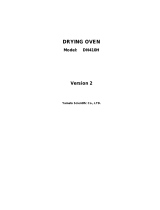
M (E2) 04/2019 page 3/71
9.7
Starting a previously entered program .............................................................................................. 34
9.8 Deleting a program............................................................................................................................ 34
9.9 Temperature profile template ............................................................................................................ 35
9.10 Program table template ..................................................................................................................... 36
10. TEMPERATURE SAFETY DEVICES ................................................................... 37
10.1 Temperature safety device class 2 (DIN 12880) .............................................................................. 37
10.2 Temperature safety device class 3.1 (DIN 12880) (available via BINDER INDIVIDUAL customized
solutions) ........................................................................................................................................... 38
11. OPTIONS .............................................................................................................. 39
11.1 APT-COM™ 4 Multi Management Software (option)........................................................................ 39
11.2 Ethernet interface .............................................................................................................................. 39
11.3 HEPA fresh air filter (option) ............................................................................................................. 39
11.4 Data logger kit (option) ...................................................................................................................... 40
11.5 Additional flexible Pt100-temperature sensor (option) ...................................................................... 40
11.6 Analog output for temperature (option) ............................................................................................. 40
11.7 Additional measuring channel for digital object temperature indicator with flexible temperature
sensor Pt 100 (option) ....................................................................................................................... 41
11.8 Mostly gas-tight version (option for M 53 and M 115) ...................................................................... 41
11.9 Inert gas connection with mostly gas-tight version (option for M 53 and M 115) ............................. 42
11.10 Keyboard locking (option) ................................................................................................................. 44
12. MAINTENANCE, CLEANING, AND SERVICE .................................................... 44
12.1 Maintenance intervals, service .......................................................................................................... 44
12.2 Cleaning and decontamination ......................................................................................................... 45
12.2.1 Cleaning .................................................................................................................................. 45
12.2.2 Decontamination ..................................................................................................................... 47
12.3 Sending the chamber back to BINDER GmbH ................................................................................. 48
13. DISPOSAL............................................................................................................ 48
13.1 Disposal of the transport packing ..................................................................................................... 48
13.2 Decommissioning .............................................................................................................................. 49
13.3 Disposal of the chamber in the Federal Republic of Germany ......................................................... 49
13.4 Disposal of the chamber in the member states of the EU except for the Federal Republic of
Germany ........................................................................................................................................... 50
13.5 Disposal of the chamber in non-member states of the EU ............................................................... 51
14. TROUBLESHOOTING ......................................................................................... 52
15. TECHNICAL DESCRIPTION ................................................................................ 53
15.1 Factory calibration and adjustment ................................................................................................... 53
15.2 Definition of usable volume ............................................................................................................... 53
15.3 Over current protection ..................................................................................................................... 54
15.4 Technical data ................................................................................................................................... 54
15.5 Equipment and options (extract) ....................................................................................................... 56
15.6 Accessories and spare parts (extract) .............................................................................................. 57
15.7 Dimensions M 53 .............................................................................................................................. 58
15.8 Dimensions M 115 ............................................................................................................................ 59
15.9 Dimensions M 240 ............................................................................................................................ 60
15.10 Dimensions M 400 ............................................................................................................................ 61
15.11 Dimensions M 720 ............................................................................................................................ 62
16. EU DECLARATION OF CONFORMITY ............................................................... 63
17. PRODUCT REGISTRATION ................................................................................ 65
18. CONTAMINATION CLEARANCE CERTIFICATE ............................................... 66
18.1 For chambers located outside the USA and Canada ....................................................................... 66
18.2 For chambers located in the USA and Canada ................................................................................ 69

























